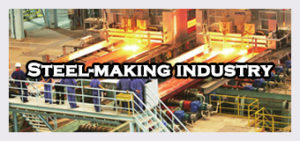Steelmaking Industry
Steelmaking is the process for producing steel from iron ore and scrap. In steelmaking, impurities such as nitrogen, silicon, phosphorus, sulfur and excess carbon are removed from the raw iron, and alloying elements such as manganese, nickel, chromium and vanadium are added to produce different grades of steel. Limiting dissolved gases such as nitrogen and oxygen, and entrained impurities (termed “inclusions”) in the steel is also important to ensure the quality of the products cast from the liquid steel.
and vanadium are added to produce different grades of steel. Limiting dissolved gases such as nitrogen and oxygen, and entrained impurities (termed “inclusions”) in the steel is also important to ensure the quality of the products cast from the liquid steel.
Steelmaking has existed for millennia, but it was not commercialized until the 19th century. The ancient craft process of steelmaking was the crucible process. In the 1850s and 1860s, the Bessemer process and the Siemens-Martin process turned steelmaking into a heavy industry. Today there are two major commercial processes for making steel, namely basic oxygen steelmaking, which has liquid pig-iron from the blast furnace and scrap steel as the main feed materials, and electric arc furnace (EAF) steelmaking, which uses scrap steel or direct reduced iron (DRI) as the main feed materials. Oxygen steelmaking is fuelled predominantly by the exothermic nature of the reactions inside the vessel where as in EAF steelmaking, electrical energy is used to melt the solid scrap and/or DRI materials. In recent times, EAF steelmaking technology has evolved closer to oxygen steelmaking as more chemical energy is introduced into the process.
The following hoses can be applicated to steelmaking industry:

